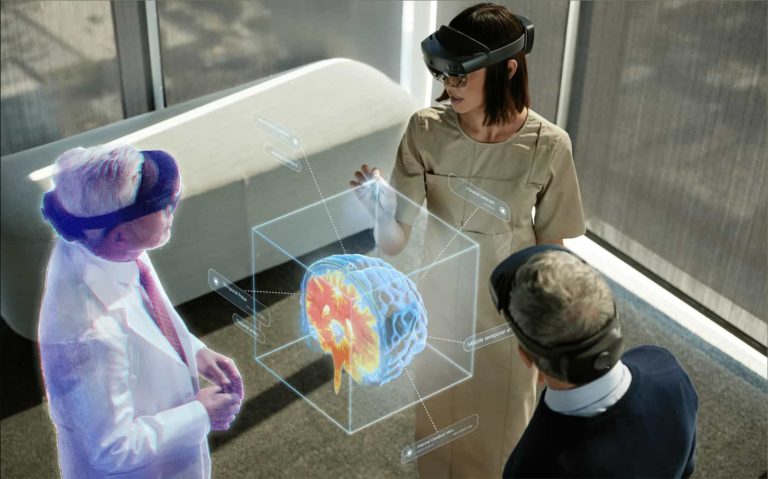
As you likely know, one of AR’s foundational principles is to fuse the digital and physical. The real world is a key part of that formula… and real-world relevance is often defined by location. That same relevance and scarcity are what drive real estate value….location, location, location.
Synthesizing these factors, one of AR’s battlegrounds will be in augmenting the world in location-relevant ways. That could be wayfinding with Google Live View, or visual search with Google Lens. Point your phone (or future glasses) at places and objects to contextualize them.
As you can tell from the above examples, Google will have a key stake in this “Internet of Places.” But it’s not alone. Apple signals interest in location-relevant AR through its geo-anchors and Project Gobi. Facebook is building “Live Maps,” and Snapchat is pushing Local Lenses.
These are a few utilitarian, commerce, and social angles. How else will geospatial AR materialize? What are its active ingredients, including 5G and the AR cloud? This is the theme of our new series, Space Race, where we break down who’s doing what….continuing here with Microsoft.
Owning Enterprise AR
Among tech giants investing in AR, Microsoft continues to show strong signs as a leading platform for enterprise productivity. That not only includes its best-of-breed hardware in the Hololens 2, but an expanding suite of software (it is Microsoft after all) for enterprise AR.
This ties to Microsoft’s DNA, as enterprise productivity has been its core business for 30 years. In that sense, it embodies our “follow the money” principle: tech giants’ XR trajectories can be projected based on their financial motivations — usually to future-proof core businesses.
This pattern holds true for Microsoft’s work in AR, which can be seen in the enterprise-first Hololens 2. But how does it apply to the geolocation theme of this series? The answer is Microsoft Mesh: the company’s new organizing structure for a productivity-enabling AR Cloud.
Mesh represents the culmination of many of the AR puzzle pieces that Microsoft has been assembling for the past few years. These include its AR productivity apps such as Spatial Anchors, 365 Assist, and several other components of its full-stack approach to Enterprise AR.
Cloud-Forward
As further background for Microsoft’s AR moves, CEO Satya Nadella is a verdant cloud proponent. In fact, it was under his watch that Microsoft defied a classic innovator’s dilemma and embraced the cloud, even though it deviated from the structure of its then software business.
It’s within that reborn cloud culture that Microsoft’s AR efforts germinate. And it’s those guiding principles that will drive its AR positioning. As noted, Microsoft is taking a full-stack approach to AR, owning the hardware (Hololens), operating system (WMR) and cloud data (Azure).
In addition to those foundational components, Microsoft is naturally positioning itself at the application layer. Dynamics 365 Assist and Azure Spatial Anchors can be thought of as a sort of Microsoft Office of AR. But with a true platform play, it also welcomes developers to build AR apps.
That’s where Mesh comes in. It’s essentially the culmination of all of the pieces outlined above, with some additional functionality such as collaboration through Microsoft Teams. It formalizes and federates these pieces in one place and is now the center of Microsoft’s AR universe.
Fertile Soil
With that structural and strategic backdrop, what exactly is Mesh? It’s a software architecture that enables spatially oriented computing interactions. It localizes people and objects in space and provides a framework for the interactions with and between those entities.
In more practical and plain-spoken terms, it lets users envision objects in their immediate space, such as a product design or architectural model. More importantly, it can do this with “holo-portation “and multi-user functionality. This opens up the use case to collaborative work.
All of this of course resonates during a pandemic, as well as post-Covid “hybrid” work environments. Being able to more materially interact with people and work elements will find fertile soil in that world. Those work elements can be everything from a whiteboard to a 3D CAD model.
Mesh will also play a part in geo-located enterprise AR use cases such as bridge inspection (see below). These applications incorporate Azure Digital Twins, a key corollary to Mesh that Microsoft continues to expand, including a recent move into construction and real estate.
Age of Creation
As noted, Mesh is a platform on which developers build apps. As platforms go, this could accelerate Mesh’s utility by scaling its experience creation. Microsoft has also intelligently made Mesh cross-platform so it can reach network effect faster through broad end-user compatibility.
This mindset traces back to Nadella’s comments at the recent Ignite event: The last decade has been all about digital consumption, while the next decade will be all about empowering creation. If Microsoft has a part in shaping that future, much of it will be in six dimensions.

